2022-2023 学年辽宁省大连市高三上学期期末英语试题及答
案
注意事项:
1.答卷前,考生务必将自己的姓名、准考证号填写在答题卡上。
2.作答时,务必将答案写在答题卡上,写在本试卷及草稿纸上无效。
第一部分 听力(共两节,满分 30 分)
做题时,先将答案标在试卷上。录音内容结束后,你将有两分钟的时间将试卷上的答案转
涂到答题卡上。
第一节(共 5 小题;每小题 1.5 分,满分 7.5 分)
听下面 5 段对话。每段对话后有一个小题,从题中所给的 A、B、C 三个选项中选出最佳选
项。听完每段对话后,你都有 10 秒钟的时间来回答有关小题和阅读下一小题。每段对话仅
读一遍。
例:How much is the shirt?
A. £19.15.
答案是 C。
B. £9.18.
C. £9.15.
1. When did the match actually start?
A. At 5:45 pm.
B. At 6:15 pm.
C. At 6:30 pm.
2. What does the man mean?
A. He prefers study to a picnic.
B. He dislikes autumn.
C. He is rather
busy.
3. What is the probable relationship between the speakers?
A. Interviewer and interviewee.
B. Boss and secretary.
C. Host and
guest.
4. What does the man intend to do?
A. Make friends.
B. Collect papers.
C. Do the typing.
5. Which shoes are more expensive?
A. The red ones.
B. The white ones.
C. The blue ones.
第二节(共 15 小题;每小题 1.5 分,满分 22.5 分)
听下面 5 段对话或独白。每段对话或独白后有几个小题,从题中所给的 A、B、C 三个选项
中选出最佳选项。听每段对话或独白前,你将有时间阅读各个小题,每小题 5 秒钟;听完
后,各小题将给出 5 秒钟的作答时间。每段对话或独白读两遍。
听第 6 段材料,回答第 6、7 题。
6. Why does the woman want the man to turn the TV up?
A. To watch the weather report.
B. To watch the news.
C. To watch
advertisements.
7. What’s the winter like in this area?
�
A. It’s not cold.
B. It is often windy.
C. It seldom snows.
听第 7 段材料,回答第 8 至第 10 三个小题。
8. What does the man want to do?
A. Open an account.
B. Save some money.
C. Withdraw some money.
9. Why does the man have to wait?
A. The power is off.
B. There are many people.
C. The computer is down.
10. When will the man take the money?
A. A few minutes later.
B. Tomorrow.
C. Several hours later.
听第 8 段材料,回答第 11 至第 13 三个小题。
11. What’s the Course Five-one-four about?
A. Children’s literacy.
B. Testing.
C. Advanced maths.
12. What can help the woman change the course?
A. Her records.
B. Her papers.
C. Her degree.
13. What is the woman going to do next?
A. Sign her name.
B. Fix the paper up.
C. Go to another office.
听第 9 段材料,回答第 14 至第 17 四个小题。
14. Who is the man?
A. A physician.
B. An operator.
C. A nurse.
15. What’s wrong with the woman’s brother?
A. He hurt his leg.
B. He was out of breath.
16. What information is needed?
C. He lost consciousness.
A. The brother’s name.
B. The woman’s location.
C. The woman’s phone
number.
17. What is the man’s suggestion?
A. Keeping cool.
B. Sending for a doctor.
C. Moving to a safe place.
听下面一段独白,回答第 18 至第 20 三个小题。
18. What is the talk mainly about?
A. The basic information of milu deer.
B. The importance of deer conservation.
C. The relationship between deer and man.
19. What do the milu deer eat in autumn?
A. Grass.
B. Fruits and nuts.
C. Dry leaves.
20. What makes a milu deer different from other deer?
A. A better sense of smell.
B. Brighter colour.
C. Bigger feet.
第二部分 阅读(共两节,满分 50 分)
第一节(共 15 小题;每小题 2.5 分,满分 37.5 分)
阅读下列短文,从每题所给的 A、B、C、D 四个选项中选出最佳选项。
�
A
。
WRITE TO US! SEND US YOUR STORIES,
JOKES AND LETTERS OR VISIT OUR WEBSITE
WE PAY...
£50 for the star letter and
CUSTOMER SERVICES
£30 for regular letters.
Contact Customer Services for renewals (续
Email readers
订),
letters@readersdigest.co.uk
address changes, payments, account
or go to
information and all other information.
readersdigest.co.uk/contact-us
Call 033 0333 2220 or email
WE ALSO PAY...
customer_service@readersdigest.co.uk
£30 for the true stories and
TALKING MAGAZINES
£20 for jokes in Laugh!
Readers Digest is also available in audio
Email excerpts@readersdigest.co.uk
and etext editions from RNIB Newsagent,
or go to
for blind and partially sighted readers.
readersdigest.co.uk/contact-us
Call the RNIEB Helpline on 030 3123 9999
SORRY!
or visit rnilb.org.uk/newsagent
We cannot acknowledge or return
SUBSCRIPTIONS
unpublished items. Do not send
Annual subscriptions are available to be
SAEs. Long stories, poetry
delivered monthly direct to your door.
and cartoons are not requested.
For our latest offers, please visit
Ensure submissions are not
readersdigest.co.uk/subscribe
previously published.
Gift subscriptions are also available.
1. Which of the following submissions are welcome?
A. Funny jokes.
B. Fantasy stories.
C. Poems.
D.
Published letters.
�
2. How can readers get talking magazines?
A. Email excerpts @readersdigest.co.uk.
B. Go to
readersdigest.co.uk/contact-us.
C. Call 033 0333 2220.
D. Visit rnilb.org.uk/newsagent.
3. What can subscribers do?
A. Buy any previous issue.
B. Enjoy home delivery service.
C. Pay subscription fees monthly.
D. Contact Customers Service for
latest offers.
【答案】1. A
2. D
3. B
【解析】
【导读】本文是一篇应用文。本文介绍了 Reader’sDigest 杂志的投稿、订阅、客服等方
面的信息。
【1 题详解】
细节理解题。根据文章“WE ALSO PAY...”部分“£20 for jokes in Laugh (笑话稿费 20
英镑)”可知,杂志收录笑话的投稿。而文中左边第三部分“Long stories, poetry and
cartoons are not requested. Ensure submissions are not previously published.(不
要求长故事、诗歌和卡通。确保提交的内容以前没有发表过。)”以及“£30 for the true
stories (真实故事稿费 20 英镑)”可知,幻想的故事、诗歌和已发表作品不需要,因此 BCD
选项不符合。故选 A 项。
【2 题详解】
细节理解题。根据问题题干“talking magazines”定位到右边第二部分,文章中的网址“visit
rnilb.org.uk/newsagent”可知,要订阅杂志可以登录这个网站。故选 D 项。
【3 题详解】
细节理解题。根据问题题干“subscribers”定位到右边第三部分,文中“Annual
subscriptions are available to be delivered monthly direct to your door.(年度订
阅可每月直接送货上门。)”可知,年度订阅可以享受送货服务。故选 B 项。
Cities have been described as essential to climate change solutions, but they
can also raise the kinds of ecologists that will bring us into a more comprehensive
B
biological future.
�
As a black wildlife biologist from Philadelphia, I stood out among my coworkers.
My presence in ecology has challenged assumptions about not only what a biologist
looks like, but also where a biologist comes from. In the U.S., ecology was and is
mainly white and conducted in rural landscapes, but I had no history of camping,
fishing, hunting or hiking. I had yet to recognize that Philadelphia, with its four
seasons and richness of squirrels (松鼠), row homes and festivals, was actually my
first ecological classroom. There I witnessed wild cats eating birds and rats, people
shooting bats from their homes and snakes being killed by lawn mowers (割草机). This
is as much ecology in action as anything we witness in fields and forests.
Urban wild animals exhibit many features and behaviors that set them apart from
their rural twins: they may be bigger, eat more diverse food sources, are active
at different times of the day, move differently and have different personalities.
Some biologists argue they are even “smarter”. Besides, urban wildlife balances
more risks—such as road chemical poisons and diseases from domestic animals—with
rewards. Some of those rewards come from humans providing food and some from the
distribution of our parks and water bodies.
In our professional lives as biologists, living with such wild animals can make
us more tolerant of species diversity, which can benefit the natural world. Nature
is no longer only primitive wilderness but includes sounds of human laughter and
garbage trucks. We expect more biologists from urban settings because urban
environments naturally train keen observers who are the future of ecology.
4. Which makes the author stand out among his coworkers?
A. His nationality.
B. His city background.
C. His interest in outdoor activities.
D. His love for animals.
5. What does the underlined “they” in paragraph 3 refer to?
A. Urban wild animals.
B. Rural animals.
C. Domestic animals.
D. Wildlife biologists.
6. What do we know about urban wild animals?
A. They have trouble in getting food.
B. They enjoy safer living
�
conditions.
C. They do better in fighting diseases.
D. They are more adaptable to
environment.
7. Which of the following is a suitable title for the text?
A. Urban Wild Animals Survive.
B. Benefits of City Conservation.
C. Cities Build Better Biologists.
D. A Black Biologist from
Philadelphia.
【答案】4. B
5. A
6. D
7. C
【解析】
【导语】本文是一篇说明文。文章讲述了一个来自城市的生物学家认为城市的生态系统和野
外的生态系统一样值得研究,并且期待未来能有更多来自城市环境的生物学家一起创造生态
学的未来。
【4 题详解】
细节理解题。根据第二段“As a black wildlife biologist from Philadelphia, I stood
out among my coworkers.”(作为一名来自费城的黑人野生动物生物学家,我在同事中脱颖
而出。)可知,作者与其他的生物学家与众不同的地方在于他的城市背景。故选 B 项。
【5 题详解】
词义猜测题。根据第三段“Urban wild animals exhibit many features and behaviors that
set them apart from their rural twins: they may be bigger, eat more diverse food
sources, are active at different times of the day, move differently and have
different personalities.”(城市野生动物表现出许多将他们与农村的双胞胎兄弟们区分
开来的特征和行为:他们更大,食物来源更加多样,在一天中不同的时间段活动,行动也不
同并且有不同的性格。)可知,第三段中的 they 指代的是上文提到的城市的野生动物。故选
A 项。
【6 题详解】
推理判断题。根据第三段“Besides, urban wildlife balances more risks—such as road
chemical poisons and diseases from domestic animals—with rewards. Some of those
rewards come from humans providing food and some from the distribution of our parks
and water bodies.”(此外,城市野生动物还能有回报地平衡更多的风险——如道路化学毒
物和来自家禽的疾病。其中一些这样的回报来自于人类提供的食物,还有一些来自公园和水
�
体的分布。)可知,和乡村的野生动物相比,城市野生动物善于利用城市环境生存,推断出
他们更加适应环境。故选 D 项。
【7 题详解】
主旨大意题。根据第一段“Cities have been described as essential to climate change
solutions, but they can also raise the kinds of ecologists that will bring us into
a more comprehensive biological future.”(城市对气候改变的解决方式至关重要,但他
们也可以培养出各种生态学家,将我们带入一个更全面的生态学未来。)和最后一段“We
expect more biologists from urban settings because urban environments naturally
train keen observers who are the future of ecology.”(我们期待更多来自城市环境的
生物学家,因为城市环境培养出对于生态环境的未来敏锐的观察者。)可知,文章首尾呼应,
点明主题——城市可以培养出更好的生物学家。故选 C 项。
C
Chatting in her bright two bedroom flat, Shirley Meredeen, aged 91, doesn’t
hesitate in describing the benefits of living here. “It keeps my brain going. We
are all very active because there is so much to do...We’re really lucky to have
such a supportive community.”
In 1998, Meredeen first heard of the concept of cohousing as developed in the
Netherlands and decided to copy its model in the UK and create the Older Women
Cohousing (OWCH) with her friends. But they didn’t imagine that it would be an 18-year
struggle. The novelty of the idea coupled with the lack of data to prove the social
and economic benefits made it difficult for them to access public money. Councils
always compared their idea to sheltered accommodation and saw it as a burden for
their already overstretched budgets.
In fact, the community-led housing is a departure from the conventional
understanding of later life. Now, the community comprises 25 flats as well as a shared
kitchen, meeting room, laundry, garden, car park and a guest room. People live
together based on interdependence. They can take control of their future instead
of relying on their families or care homes. All the neighbours look out for each
other, not after each other, which means accompanying to medical appointments, doing
the local shopping, having family contacts in preparation for an emergency... But
�
the limits of such informal care among residents still need to be worked out.
OWCH has paved the way to alternative living arrangements in later life and the
support for community-led housing is starting to emerge in the form of guidance and
funding, according to UK Cohousing Network.
8. What do we know about Meredeen?
A. She first tried cohousing in the Netherlands.
B. She is a regular visitor to OWCH.
C. She is a pioneer in elderly care service.
D. She founded OWCH single-handed.
9. Why did it take such a long time to set up OWCH?
A. It didn’t benefit social economy.
B. It didn’t keep up with the time.
C. It called for careful budgeting.
D. It was hard to get public
funding.
10. Which is probably the reason why seniors choose OWCH?
A. They are more independent.
B. They are responsible for each
other.
C. They receive more care services.
D. They can rely on their
relatives.
11. What is the purpose of the text?
A. To describe an ambitious figure.
B. To introduce a new lifestyle of
seniors.
C. To ensure elderly people’s welfare.
D. To inspire the aged to achieve
their dreams.
【答案】8. C
9. D
10. A
11. B
【解析】
【导语】这是一篇说明文。文章主要介绍了 Shirley Meredeen 与她的朋友一起创建“老年
女性同居”养老模式,但是这种非正式护理在居民中的局限性仍有待解决。
【8 题详解】
推理判断题。根据第二段中的“In 1998, Meredeen first heard of the concept of cohousing
as developed in the Netherlands and decided to copy its model in the UK and create
�
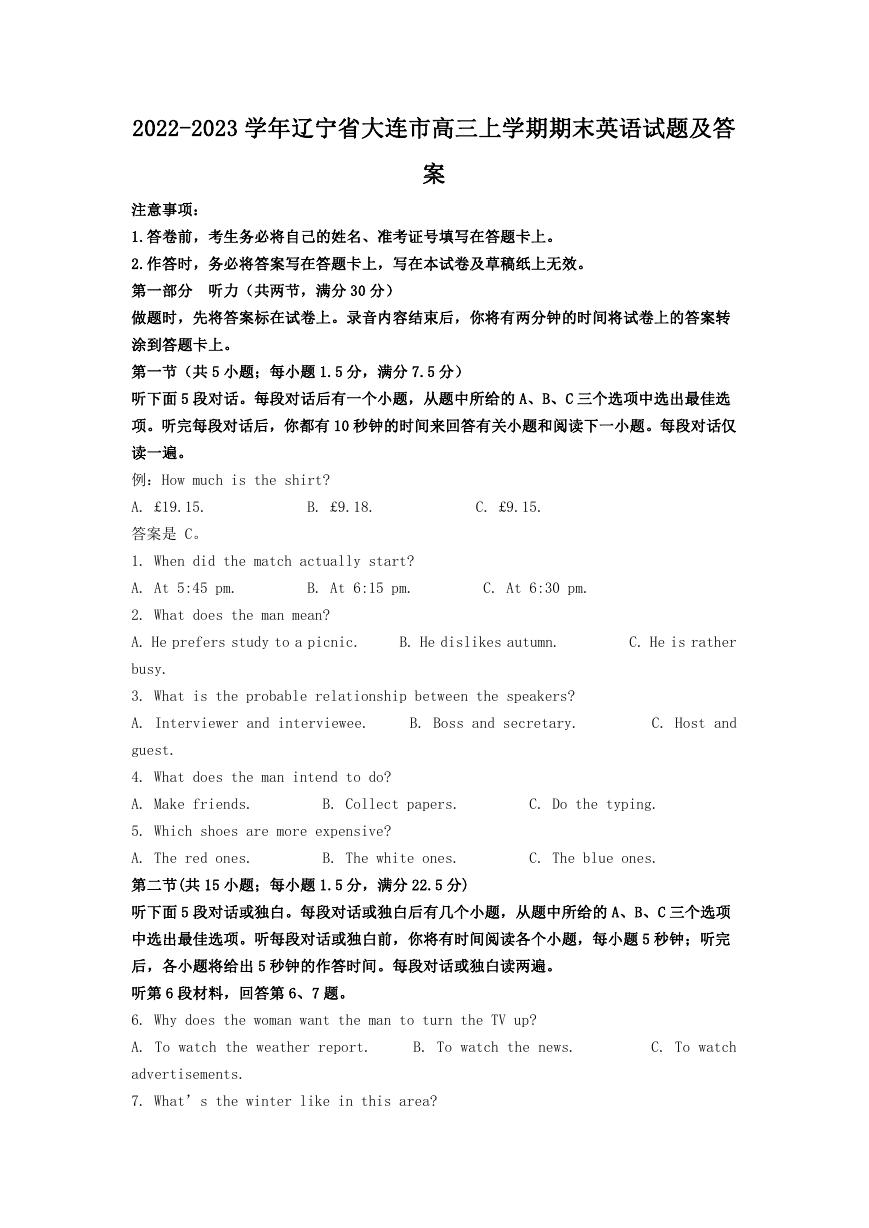
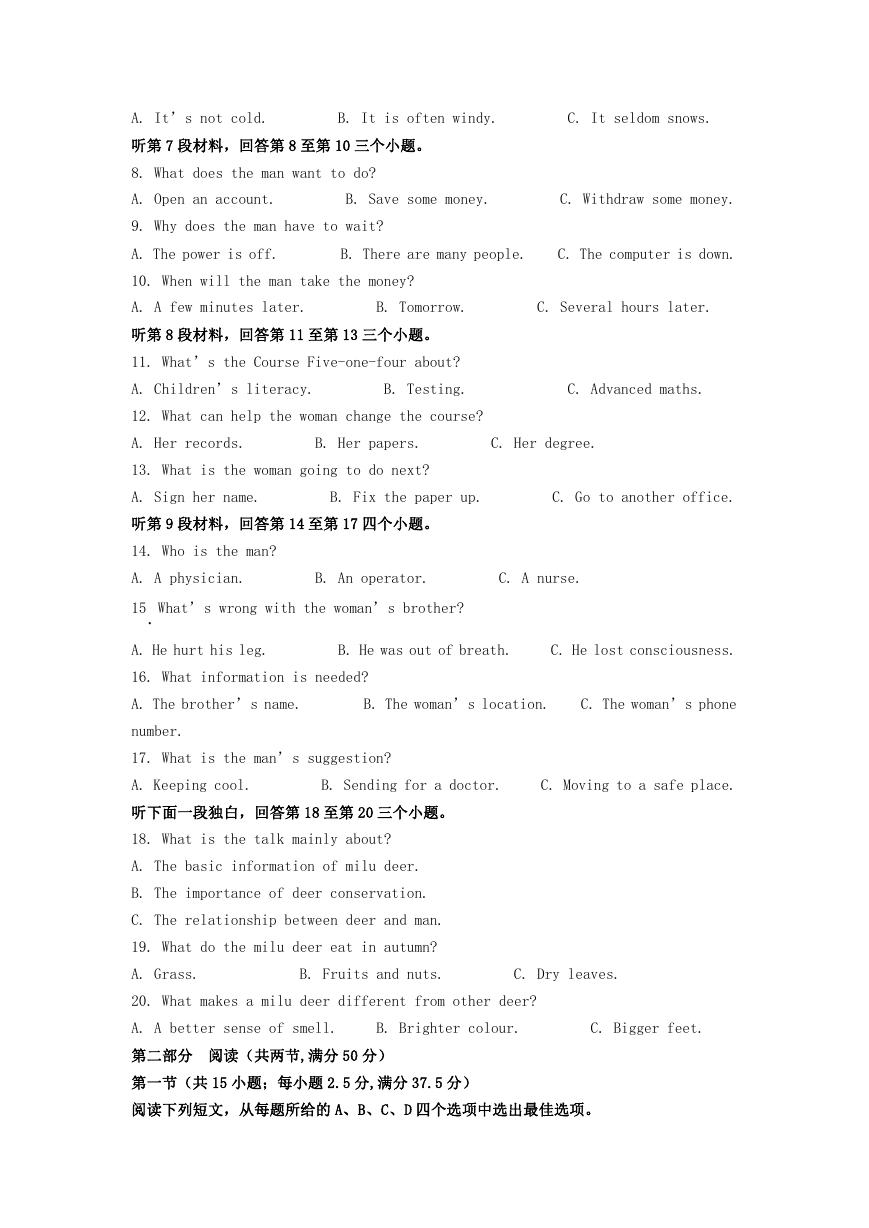
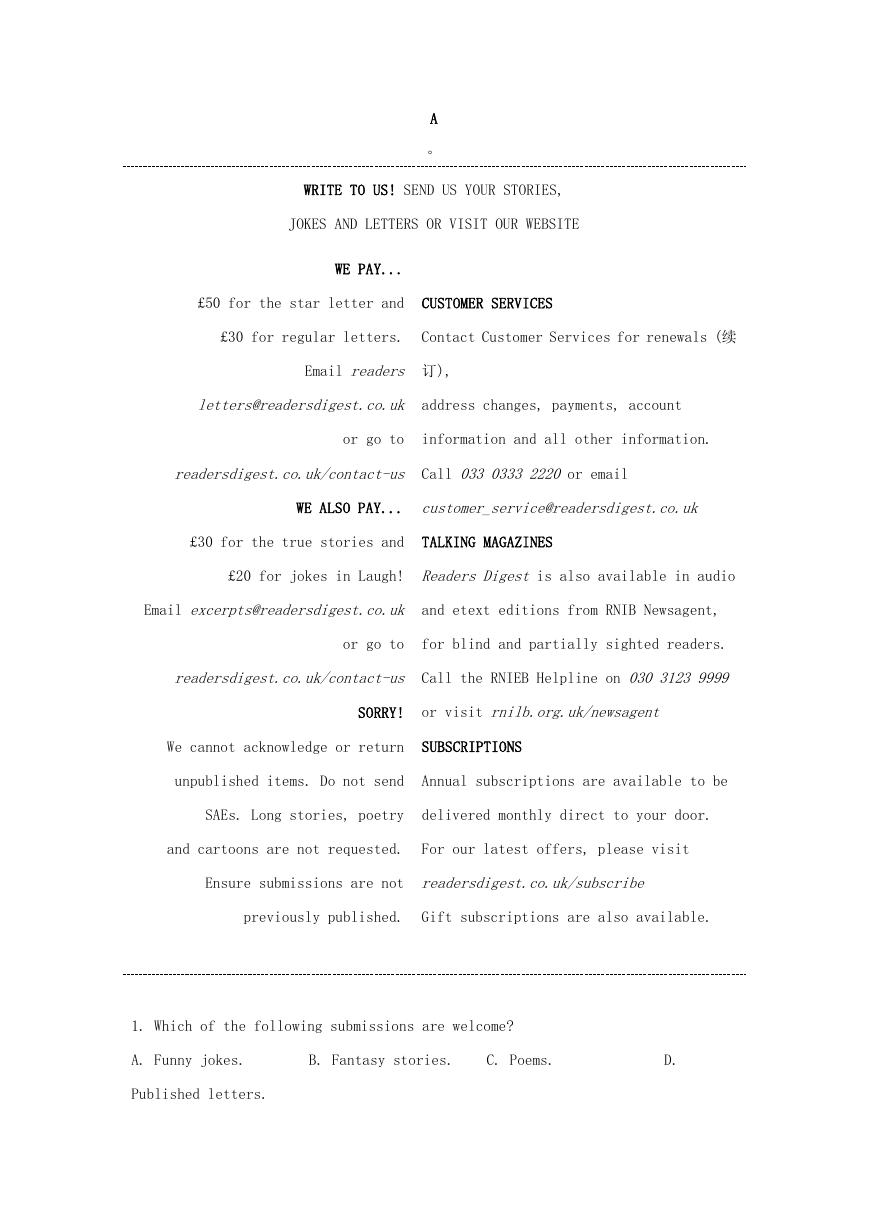


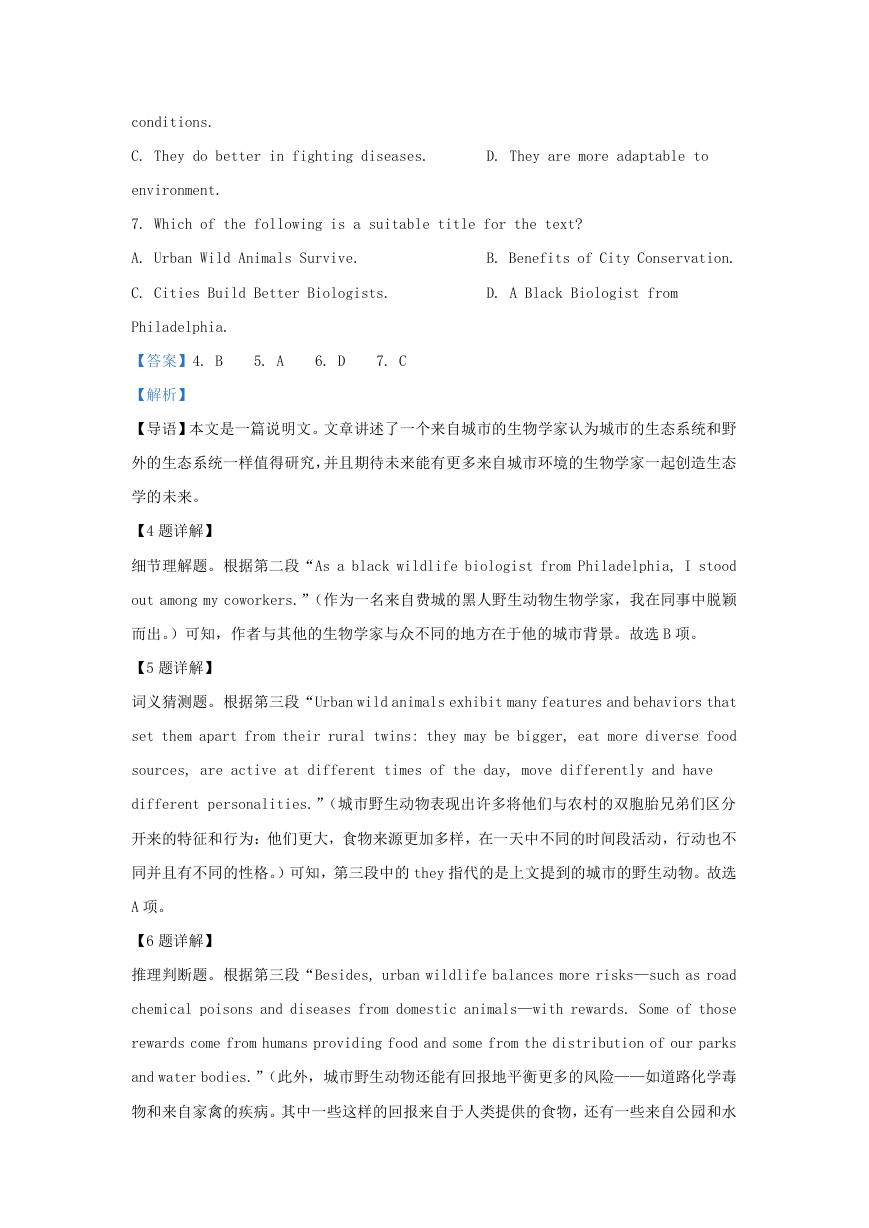
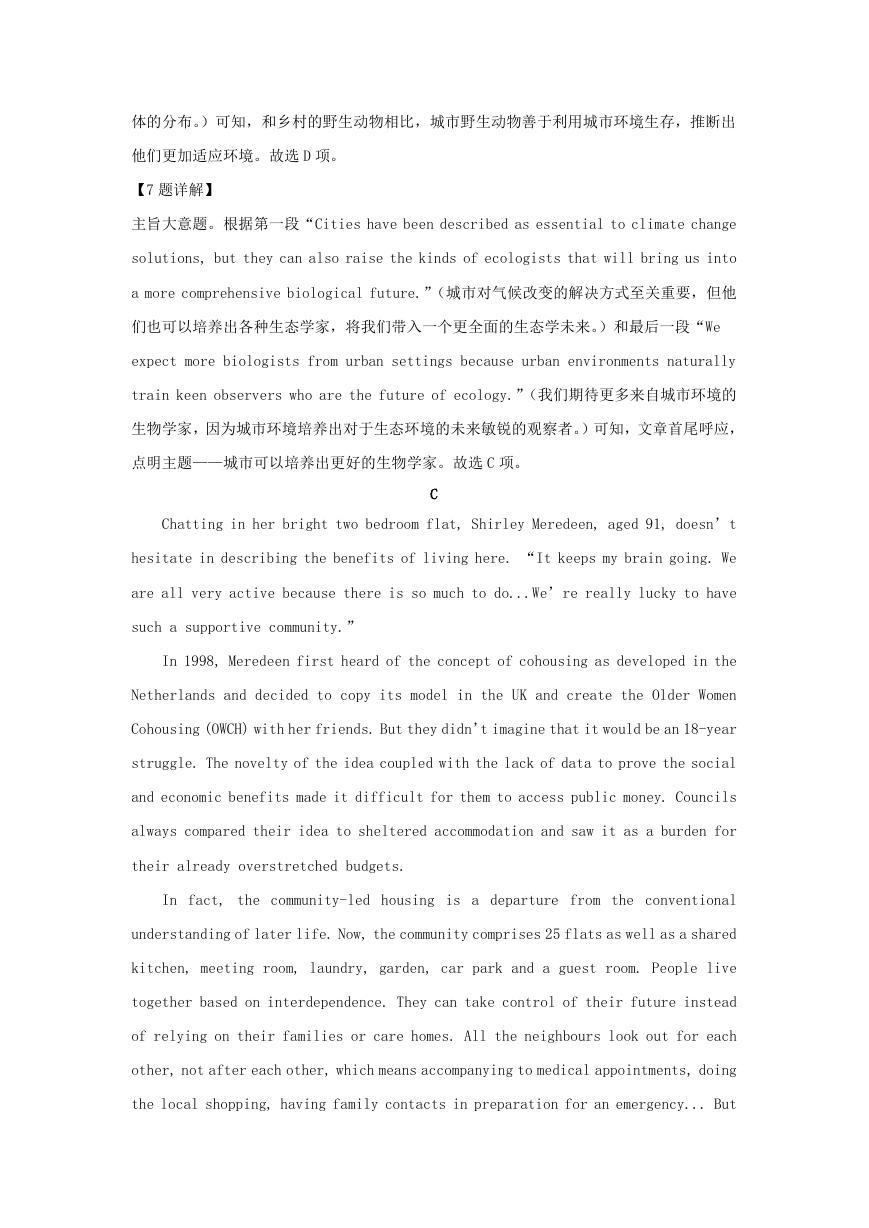









 2023年江西萍乡中考道德与法治真题及答案.doc
2023年江西萍乡中考道德与法治真题及答案.doc 2012年重庆南川中考生物真题及答案.doc
2012年重庆南川中考生物真题及答案.doc 2013年江西师范大学地理学综合及文艺理论基础考研真题.doc
2013年江西师范大学地理学综合及文艺理论基础考研真题.doc 2020年四川甘孜小升初语文真题及答案I卷.doc
2020年四川甘孜小升初语文真题及答案I卷.doc 2020年注册岩土工程师专业基础考试真题及答案.doc
2020年注册岩土工程师专业基础考试真题及答案.doc 2023-2024学年福建省厦门市九年级上学期数学月考试题及答案.doc
2023-2024学年福建省厦门市九年级上学期数学月考试题及答案.doc 2021-2022学年辽宁省沈阳市大东区九年级上学期语文期末试题及答案.doc
2021-2022学年辽宁省沈阳市大东区九年级上学期语文期末试题及答案.doc 2022-2023学年北京东城区初三第一学期物理期末试卷及答案.doc
2022-2023学年北京东城区初三第一学期物理期末试卷及答案.doc 2018上半年江西教师资格初中地理学科知识与教学能力真题及答案.doc
2018上半年江西教师资格初中地理学科知识与教学能力真题及答案.doc 2012年河北国家公务员申论考试真题及答案-省级.doc
2012年河北国家公务员申论考试真题及答案-省级.doc 2020-2021学年江苏省扬州市江都区邵樊片九年级上学期数学第一次质量检测试题及答案.doc
2020-2021学年江苏省扬州市江都区邵樊片九年级上学期数学第一次质量检测试题及答案.doc 2022下半年黑龙江教师资格证中学综合素质真题及答案.doc
2022下半年黑龙江教师资格证中学综合素质真题及答案.doc